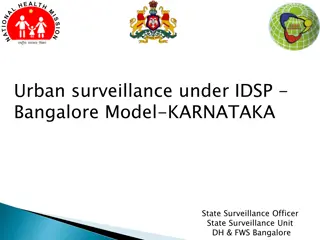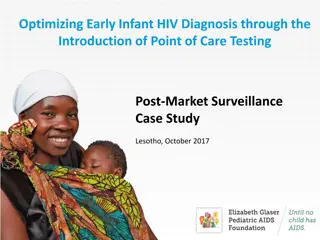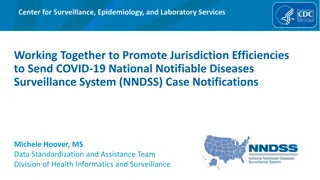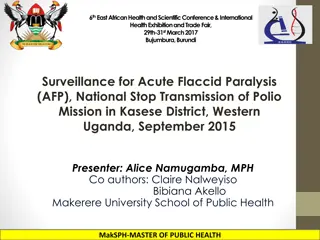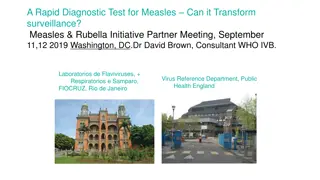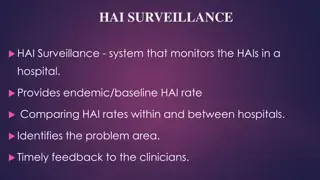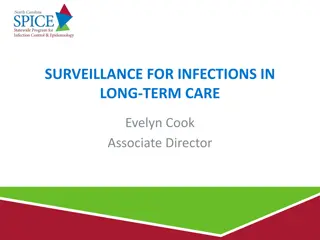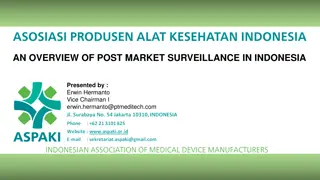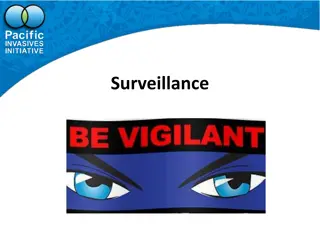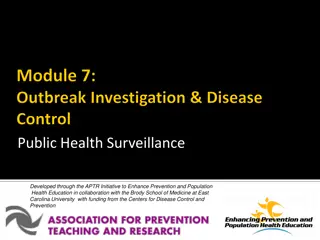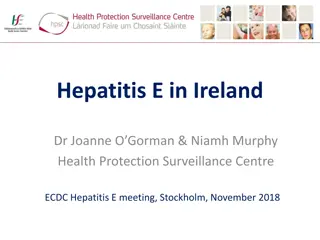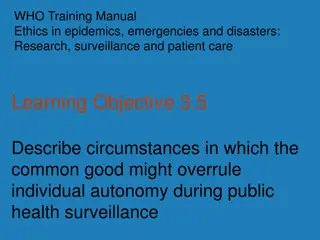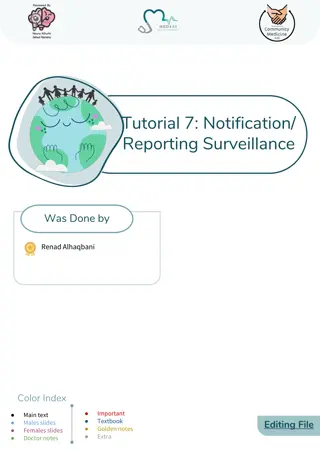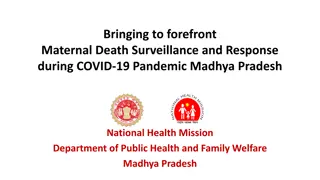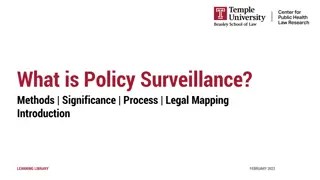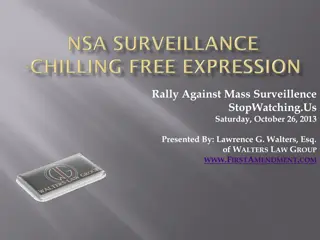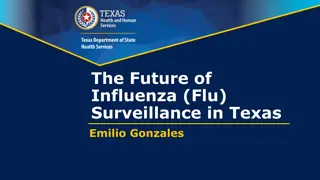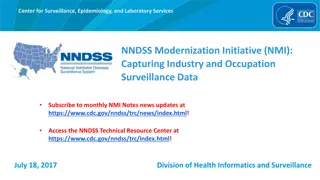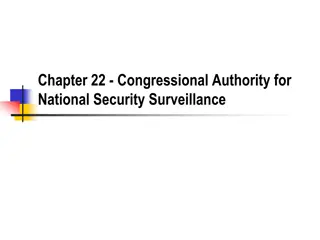Introduction to Public Health Surveillance
Public health surveillance is essential in monitoring and analyzing health concerns that affect the entire nation. From infectious disease outbreaks to chronic illnesses and environmental disasters, public health aims to improve overall health and well-being. This presentation serves as an informative introduction to the concept of public health surveillance, providing valuable insights for educators and students interested in epidemiology and public health sciences.
Download Presentation

Please find below an Image/Link to download the presentation.
The content on the website is provided AS IS for your information and personal use only. It may not be sold, licensed, or shared on other websites without obtaining consent from the author.If you encounter any issues during the download, it is possible that the publisher has removed the file from their server.
You are allowed to download the files provided on this website for personal or commercial use, subject to the condition that they are used lawfully. All files are the property of their respective owners.
The content on the website is provided AS IS for your information and personal use only. It may not be sold, licensed, or shared on other websites without obtaining consent from the author.
E N D
Presentation Transcript
CDC Science Ambassador Workshop 2014 Supplemental PowerPoint Public Health Surveillance Developed by Cindy L. Birkner, MS Webber Township High School Bluford, Illinois Johnna M. Doyle, MS Nashoba Regional High School Bolton, Massachusetts Colleen K. Lohr, MAT Rochester Adams High School Rochester Hills, Michigan In Collaboration with CDC Subject-Matter Experts Asim A. Jani, MD, MPH, FACP, Commander, USPHS Michael E. King, PhD, MSW, Commander, USPHS Division of Scientific Education and Professional Development Center for Surveillance, Epidemiology, and Laboratory Services The Science Ambassador Workshop is a career workforce training for math and science teachers. The workshop is a Career Paths to Public Health activity in the Division of Scientific Education and Professional Development, Center for Surveillance, Epidemiology, and Laboratory Services, Office of Public Health Scientific Services, Centers for Disease Control and Prevention.
Disclaimers This lesson plan PowerPoint presentation is in the public domain and may be used without restriction. Citation as to source, however, is appreciated. Links to nonfederal organizations are provided solely as a service to our users. These links do not constitute an endorsement of these organizations nor their programs by the Centers for Disease Control and Prevention (CDC) or the federal government, and none should be inferred. CDC is not responsible for the content contained at these sites. URL addresses listed were current as of the date of publication. Use of trade names and commercial sources is for identification only and does not imply endorsement by the Division of Scientific Education and Professional Development, Center for Surveillance, Epidemiology, and Laboratory Services, Centers for Disease Control and Prevention, the Public Health Service, or the U.S. Department of Health and Human Services. The findings and conclusions in this Science Ambassador Workshop lesson plan are those of the authors and do not necessarily represent the official position of the Centers for Disease Control and Prevention (CDC).
Intended Use This supplemental PowerPoint was created as an introduction to public health surveillance for use in conjunction with the 2014 Science Ambassador Workshop lesson plan entitled Epidemiology: I Have a Gut Feeling. It may also be used with other epidemiology and public health science-related teaching materials as an introduction to public health surveillance. This slide set was adapted from Centers for Disease Control and Prevention, Public Health 101 Series. Introduction to Surveillance. Available at: http://www.cdc.gov/publichealth101/instructors.html. This slide set is in the public domain and may be customized as needed by the user for informational or educational purposes. Permission from the Centers for Disease Control and Prevention is not required, but citation of the source is appreciated. Suggested Citation: Centers for Disease Control and Prevention (CDC). Science Ambassador Workshop Supplemental PowerPoint: Public Health Surveillance. Atlanta, GA: US Department of Health and Human Services, CDC; 2014. Available at: http://www.cdc.gov/excite/ScienceAmbassador/ambassador_pgm/lessonplans.htm.
Public Health Defined Public health can be defined as An approach to health that aims to improve the health of an entire nation The way in which the United States monitors, analyzes, and draws conclusions about health concerns Things that can pose a threat to public health range from infectious disease outbreaks (e.g., influenza or Ebola viruses), to chronic illnesses (e.g., heart disease, cancers, or diabetes), to environmental disasters (e.g., hurricanes, tornadoes, or earthquakes), to biologic or chemical terrorism.
What is Public Health Surveillance? The ongoing, systematic collection, analysis, and interpretation of health data, essential to the planning, implementation, and evaluation of public health practice, closely integrated with the timely dissemination to those who need to know Surveillance provides the information for descriptive epidemiology, which is Person (age, sex, description) Place (where) Time (dates, hours, days, months, years)
Who Performs Public Health Surveillance? Epidemiologists Medical professionals (doctors, nurses, clinics) Pharmacies Health insurance providers Emergency responders (9-1-1 centers, emergency management technicians) Public health departments (local, state, federal)
Why Do We Use Public Health Surveillance? Because it can estimate the size of a health problem determine where an illness is occurring geographically portray the natural history of a disease detect epidemics or define a problem generate hypotheses in research monitor changes in infectious agents detect changes in health practices facilitate emergency planning
Where Do We Get Public Health Surveillance Data? Vital records Hospital records, death certificates, birth records Surveys Schools, doctors, insurance companies Environmental monitoring systems Water or air quality Animal health data Veterinarians, farms, food manufacturing
How Are Public Health Surveillance Data Collected? Voluntary reporting Individual persons reporting (a person, doctor, or hospital) Media reports Unusual health occurrences Higher purchases of specific pharmaceuticals; excessive school absences Public health initiated surveys Calling, completing forms, reviewing public records Adapted from: Centers for Disease Control and Prevention, Public Health 101 Series. Introduction to Surveillance. Available at: http://www.cdc.gov/publichealth101/instructors.html.
How Are Public Health Surveillance Data Collected? con t. Mandatory reporting Some diseases are required to be reported to the local and state health departments (reportable diseases). Highly communicable (transmittable) diseases E.g., chickenpox High morbidity or mortality rates E.g., Ebola virus disease Strong public interest E.g., methicillin-resistant Staphylococcus aureus (often referred to as MRSA)
Public Health Surveillance Types Different ways of collecting surveillance data fall into 3 categories Passive Active Syndromic
Passive Surveillance Laboratories, physicians, or others regularly report cases of disease or death to the local or state health department Examples A doctor s office reports 2 cases of measles A nursing home reports an unusual number of older patients with unexplained rashes
Active Surveillance Local or state health departments initiate the collection of information from laboratories, physicians, health care providers, or the general population Achieves more complete and accurate reporting than passive surveillance Example: Youth Risk Behavior Surveillance surveys
Syndromic Surveillance The ongoing, systematic collection, analysis, interpretation, and application of real-time indicators for disease that allow for detection before public health authorities might otherwise identify them Example: Hospital admittance records
What Does an Ideal Surveillance System Look Like? Simple Timely Representative Flexible Sensitive Strong predictive value Acceptable to The public Health care providers Cost-effective
What Does an Ideal Surveillance System Look Like? Con t. Sensitivity Few if any missed cases Increased by having broad case definitions Positive predictive value Almost all case reports received for illnesses meet the surveillance case definition Increased by adopting a more restrictive case definition
Purposes of Public Health Surveillance Surveillance has been used for the following types of outbreaks: Food poisoning Cancer clusters Health threats after natural or human-made disasters Cholera in Haiti after the 2010 earthquake Air quality after the September 11, 2001, attacks
Purposes of Public Health Surveillance, con t. Infectious disease outbreaks Ebola Malaria Influenza Severe acute respiratory syndrome (SARS) Chronic health problems Obesity Cardiovascular diseases Asthma
Please send questions and comments to scienceambassador@cdc.gov. For more information, please contact the Centers for Disease Control and Prevention 1600 Clifton Road NE, Atlanta, GA 30333 Telephone: 1-800-CDC-INFO (232-4636)/TTY: 1-888-232-6348 Visit: http://www.cdc.gov | Contact CDC at: 1-800-CDC-INFO or http://www.cdc.gov/info The findings and conclusions in this course are those of the authors and do not necessarily represent the official position of the Centers for Disease Control and Prevention.



